PADI Open Water Diver Manual Answers Chapter 3 explained to get ready for the exam and understand the PADI Open Water Knowledge Review 3 Answers.

In PADI Open Water Diver Manual Answers Chapter 3 we focus on more practical scuba diving tips for beginner divers. In chapter 3 we cover currents, descents, ascents, buddy system, rescue scenarios, boat, and shore diving procedures.
After understanding the PADI Open Water Knowledge Review 3 Answers you are halfway through the PADI Open Water Diver course.
Question 1 – PADI Open Water Diver Manual Answers Chapter 3
Question 1: Using a reference line can help you to avoid disorientation.
Descending and ascending with a reference is always recommend, especially for beginner divers. A reference can be a line, sloping bottom, wall, or pinnacle.
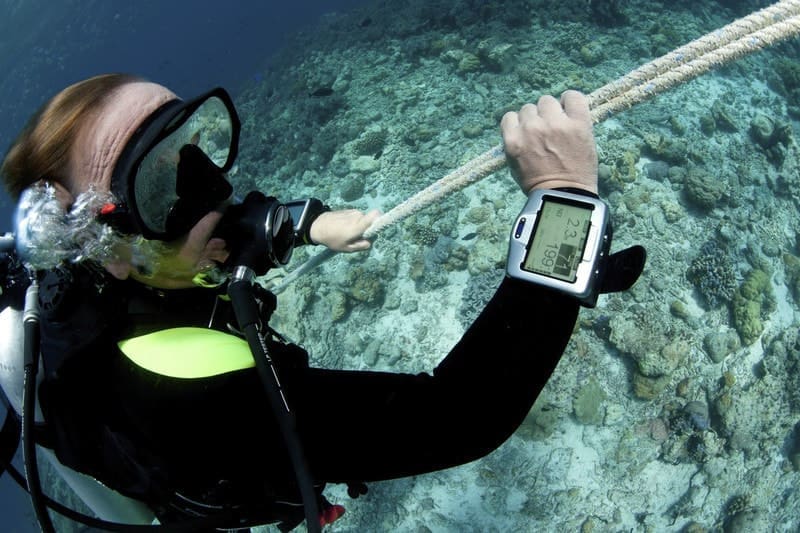
A reference can guide you to the dive site which is great in low visibility. Even better is that a reference gives you a sense of direction and tells you which way is up or down. This greatly helps to avoid disorientation underwater.
Question 2 – PADI Open Water Diver Manual Answers Chapter 3
Question 2: What should you do if there is a small current at the beginning of a dive?
Diving in a mild current is ok and mild currents are common. We recommend that you start your dive swimming against a mild current as you have more energy at the beginning of the dive.
When you turn back you will go with the current back to your starting point, which is easier and you will conserve more air for the way back.
Question 3 – PADI Open Water Knowledge Review 3 Answers
Question 3: What should you do if there is a mild current on the surface?
It is easier to swim across a current than against it. This way you can still move closer to the boat without overexerting yourself.
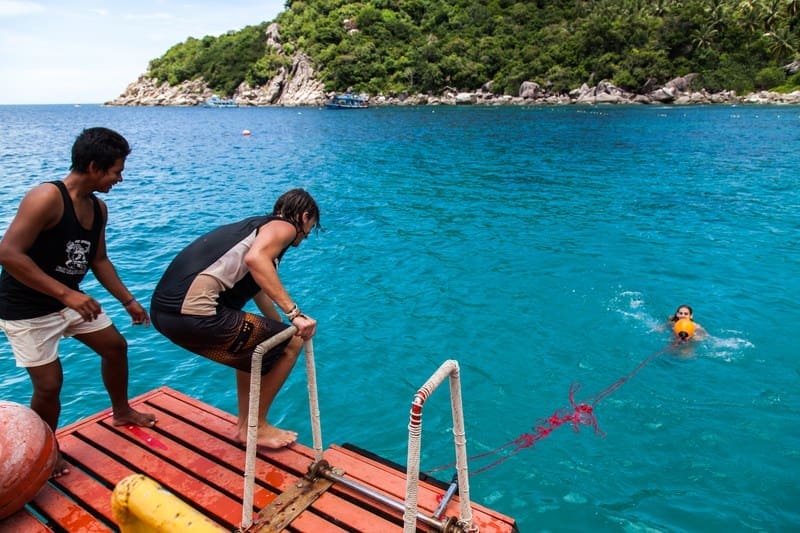
Behind the boat will be a trail line, which is a line with a buoy attached in the end. Try and grab that line and pull yourself towards the boat or the boat staff will pull you in. In the unlikely event, the current is too strong, you can signal the boat for help and they will pick you up.
Question 4 – PADI Open Water Diver Manual Answers Chapter 3
Question 4: Why is it important to avoid touching the bottom?
We must never touch the bottom as it can damage the marine life, you can stir up the bottom and you might get injured.

To do this you need to learn to control your buoyancy and you will practice this during the PADI Open Water Diver course skills. On top of that the more you scuba dive, the better your buoyancy will become.
Question 5 – PADI Open Water Diver Manual Answers Chapter 3
Question 5: Why is it important to not dive when you feel anxiety or stress?
Being nervous before the dive is more common than you think and many beginners and sometimes experienced divers feel this.
If you experience significant anxiety before the dive then please let your buddy, Divemaster, and your Dive Instructor know before the dive. Then discuss if you should continue or take a break from diving until you feel confident again.
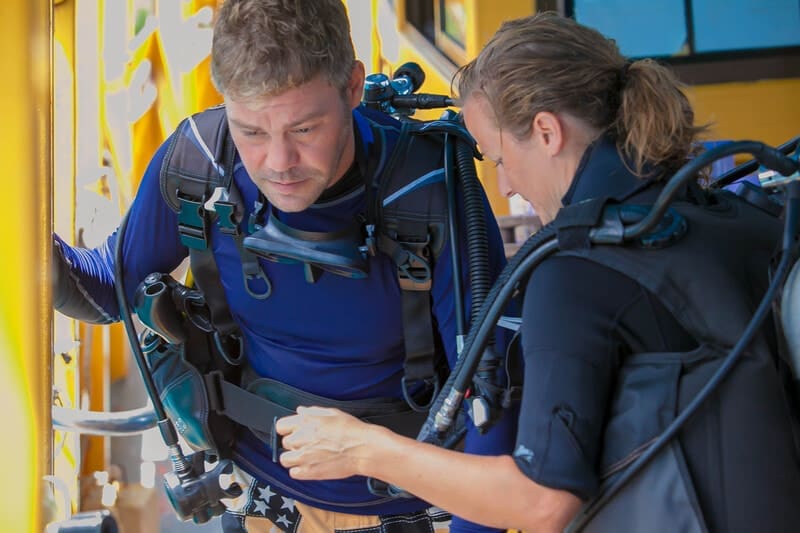
It is important to never feel ashamed about this and don’t let anyone pressure you into diving. In the end, it is your life, and don’t forget scuba diving is supposed to be fun.
Trying to scuba dive with significant anxiety can get you in a lot of trouble, so be honest to yourself.
Just remember that during your PADI Open Water Diver course you will learn scuba diving in small steps to build confidence and you will never be thrown into the deep end on your first experience. But if your anxiety is too much then you should talk to your instructor and cancel the dive.
Question 6 – PADI Open Water Knowledge Review 3 Answers
Question 6: What should you do when you dive into a new environment?
You should always get a local orientation before planning a dive on a new dive site that you are not familiar with.
Not every place with water is safe to scuba dive in. Some places have strong currents, rapidly changing tides, dangerous marine life, or other hazards.
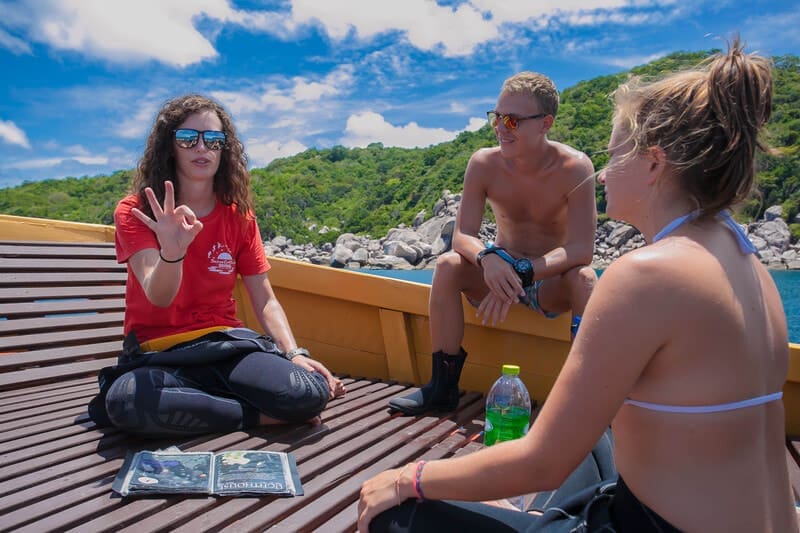
Getting a local orientation from an experienced diver or professional who knows the procedures, hazards, points of interest and other factors unique to the environment can help you plan your dive safely or decide to change dive sites if needed.
Never dive in a new environment that you are not familiar with. The best way to get a local orientation is to book an organized dive trip at a local certified dive shop.
Question 7 – PADI Open Water Diver Manual Answers Chapter 3
Question 7: It is important to understand the risk of scuba diving beyond my training level.
Some risks and hazards are not always obvious to the untrained eye. Some types of currents, marine life, tides, and other hazards are not always easy to identify. This can lead to a false sense of security or increases your anxiety levels. Feeling nervous or anxious can cloud your judgment and reaction speed.
You can solve this by taking more specialized dive training, have an experienced certified dive leader with you on a dive, or just choose to cancel the dive and plan another easier dive.
Question 8 – PADI Open Water Diver Manual Answers Chapter 3
Question 8: What should you do if anyone is pressurizing you into making a dive you don’t feel comfortable with?
Too many people feel the pressure to follow other people’s opinions, but in the end, it is your life at stake. Never let anyone pressure you in participating in a dive that you are not comfortable with.
Just ask them to change the dive plan to something that you feel good with and if someone keeps pushing you, then cancel everything and find a new dive buddy or leader. Scuba diving is supposed to be fun and safe. There is no room for ego in the scuba dive community.
Question 9 – PADI Open Water Knowledge Review 3 Answers
Question 9: How to prevent aquatic life injuries?
Being familiar with potentially hazardous animals can help you identify them easier. Never touch anything underwater, even if you are convinced the animal is harmless. Not only is it bad for the animal to disturb them, but many dangerous marine species are camouflaged or imitate the looks of a harmless animal.
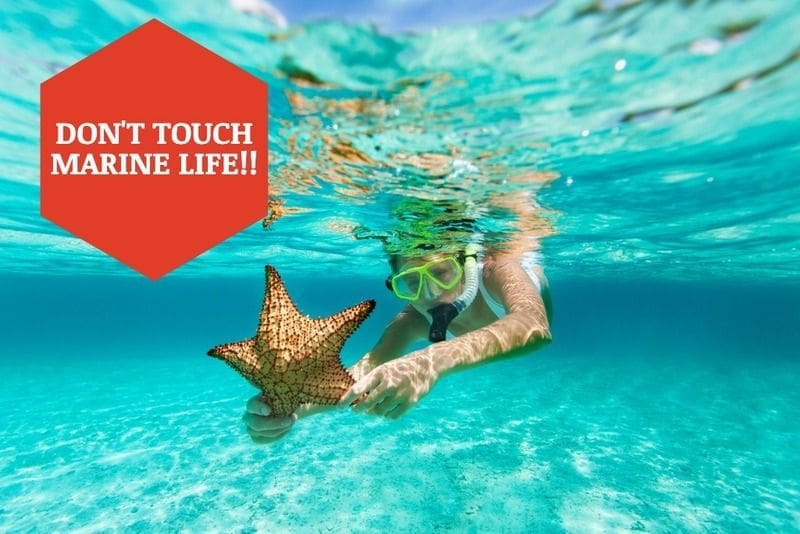
Try mastering your buoyancy before diving over the reef to prevent accidentally touching it. Practice this over a sandy bottom during your first dives.
Wearing an export suit can help you prevent cuts and stings if you accidentally touch dangerous marine life. Some divers wear gloves to be able to touch marine species. This is very bad and you should never touch anything while scuba diving.
Make sure you have a first aid kit on the boat or/and on land to treat injuries in the unlikely event you do get stung or receive a cut. Then always check with a physician afterward.
Certified Rescue Divers, EFR, Divemasters, and Diving Instructors are trained to provide basic first aid, but they are not doctors and for this reason, you should always let a licensed physician look at any dive-related injury.
Question 10 – PADI Open Water Diver Manual Answers Chapter 3
Question 10: How to deal with a rip current?
A rip current is hard to recognize with an untrained eye. They can be tricky to deal with and potentially dangerous. Rip currents are usually too strong to swim against.
We recommend you swim parallel to the rip current towards the shore. Make sure you always fully inflate your BCD when you are at the surface. In case the rip current is too strong you should signal for help and stay close to your buddy.
A local orientation can help in preventing getting catch in a rip current in the first place by not diving in areas know for rip currents.
Question 11 – PADI Open Water Diver Manual Answers Chapter 3
Question 11: How tides can affect your dives?
Tides are mainly caused by the position of the sun and moon. In some places, you hardly have any changes in the tides, which makes it easy to plan your dives.

Question 12 – PADI Open Water Knowledge Review 3 Answers
Question 12: Why a dive roster is so important?
A boat master which can be a certified Divemaster or Scuba Diving Instructor will stay on the boat looking after surface logistics and your safety.
To make sure that everyone is back on the boat before leaving the dive site, they use a dive roster to track the divers. It is common that you fill this in before and after the dive and confirm that you entered and exit the water.
Question 13 – PADI Open Water Diver Manual Answers Chapter 3
Question 13: How to get into the water?
You can enter the water with different techniques like a backward roll, giant stride or put on your scuba equipment in the water.
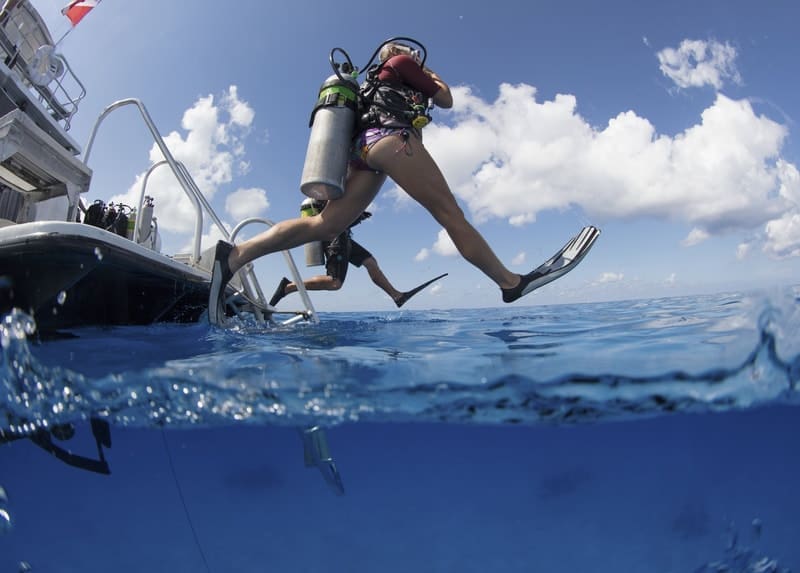
There is no best entry. In the end, it all depends on conditions and your comfort level, so choose the easiest and safest entry technique.
Question 14 – PADI Open Water Diver Manual Answers Chapter 3
Question 14: Boat propellors can be a real hazard.
Boat propellers can cause serious injuries, so it is important to stay far away from them. Even if an engine is not running you need to stay away as a captain can decide to start the engine at any time.
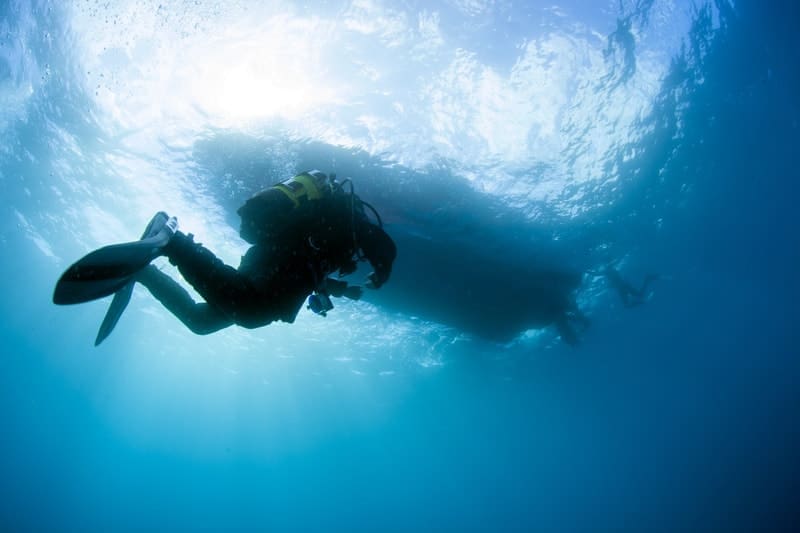
Question 15 – PADI Open Water Knowledge Review 3 Answers
Question 15: How to use a line to get you to the mooring line in a surface current?
It can be hard to swim against a mild to moderate current on the surface to the descent line. Even if you are a strong swimmer it can take a lot of energy and you might get overexerted before the dive. This can lead to stress or bad air consumption during the dive.
Using is line from the back of the boat to the descent line can help you to stay relaxed and conserve energy before descending.
Question 16 – PADI Open Water Diver Manual Answers Chapter 3
Question 16: When should you use a surface marker at the surface?
With a good dive plan, you should come back to your starting point. In the unlikely event, you might surface with no boat or float inside you should first fully inflate your BCD, stay close to your buddy, deploy your surface signaling device and wait for help.
Question 17 – PADI Open Water Diver Manual Answers Chapter 3
Question 17: What extra courses can I take to learn more about handling dive emergencies?
During your PADI Open Water Diver course, you will learn to prevent and deal with some emergencies. The PADI Rescue Diver, Emergency Oxygen Provider, and Emergency First Response Primary and Secondary Care courses specialize in rescue training for almost all scenarios.
We highly recommend you to take these courses if you plan regular dive trips and/or want to become a PADI Divemaster and/or Instructor. These courses are fun, serious, and potentially life-saving.
Question 18 – PADI Open Water Knowledge Review 3 Answers
Question 18: What is the first thing you should do when you surface?
The first thing you should always do when reaching the surface is to fully inflate your BCD to become positively buoyant.
Especially in an emergency, you want to be as positively buoyant as possible, so besides fully inflating your BCD you should also drop your weight belt or integrated weight system.
Question 19 – PADI Open Water Diver Manual Answers Chapter 3
Question 19: What should you do when you see a panicked diver at the surface?
A panicked diver at the surface usually does not respond well. It is therefore important to make sure they are positively buoyant by inflating their BCD and dropping the weight system.
Don’t forget to also inflate your BCD and drop your weight system to assist an out-of-control panic diver better. In the PADI Rescue Diver course you will learn more techniques to deal with this situation, so ask your instructor for more information on how to join this potentially life-saving course.
Question 20 – PADI Open Water Diver Manual Answers Chapter 3
Question 20: How to respond to an unresponsive diver underwater?
It is rare, but in the unlikely event, you might encounter an unresponsive diver underwater you should first get the victim to the surface.
At the surface establish positive buoyancy for you and the victim and check for breathing. If the diver is not breathing you should start rescue breaths while towing the non-breathing diver to the boat or shore.
Learn more about the temporarily updated PADI Rescue Exercise 7 Guidelines
Question 21 – PADI Open Water Knowledge Review 3 Answers
Question 21: What should you do when you feel out of breath or exhausted while scuba diving?Y
ou should always move as slow and relaxed as possible when you scuba dive. In case, you do feel overexerted you should stop all activity, rest, and signal your buddy.
When you calm down you can continue the dive. If not then you should cancel the dive and ascent slowly. There is always another dive.
Question 22 – PADI Open Water Diver Manual Answers Chapter 3
Question 22: How to deal with an unresponsive diver at the surface?
After checking for breathing and provide CPR you should prioritize contacting emergency medical care to not lose evacuation time. After EMS is on its way they can give you advice and you can continue providing CPR and First Aid.
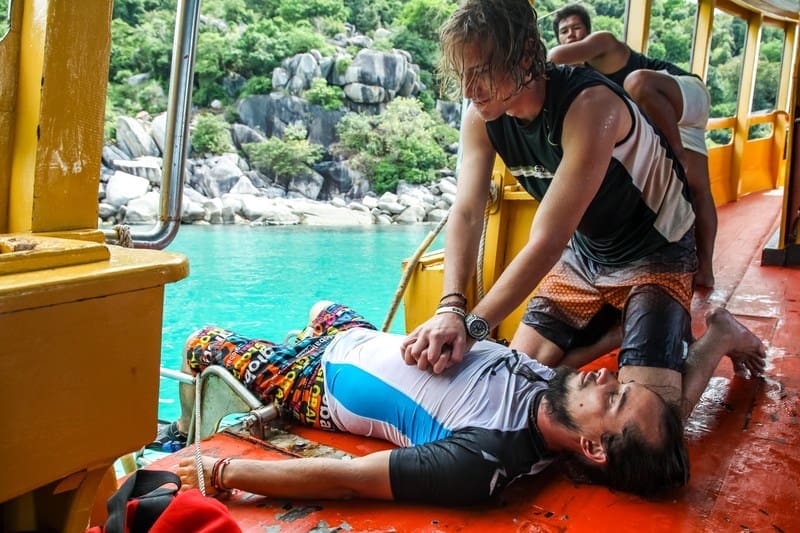
Question 23 – PADI Open Water Diver Manual Answers Chapter 3
Question 23: What is the best option when you run out of air and your buddy is too far away from you?
In the unlikely event, you run out of air and your buddy is too far away from you, you can perform a CESA – Controlled Emergency Swimming Ascent and slowly reach the surface.
Steps to perform a CESA:
- Get into the ascent position with your right hand above your head and use your left hand to deflate the BCD.
- On your last breath start swimming not faster than 18m/minute while continuously exhaling(make a continuous sound)
- At the surface orally inflate your BCD to establish positive buoyancy
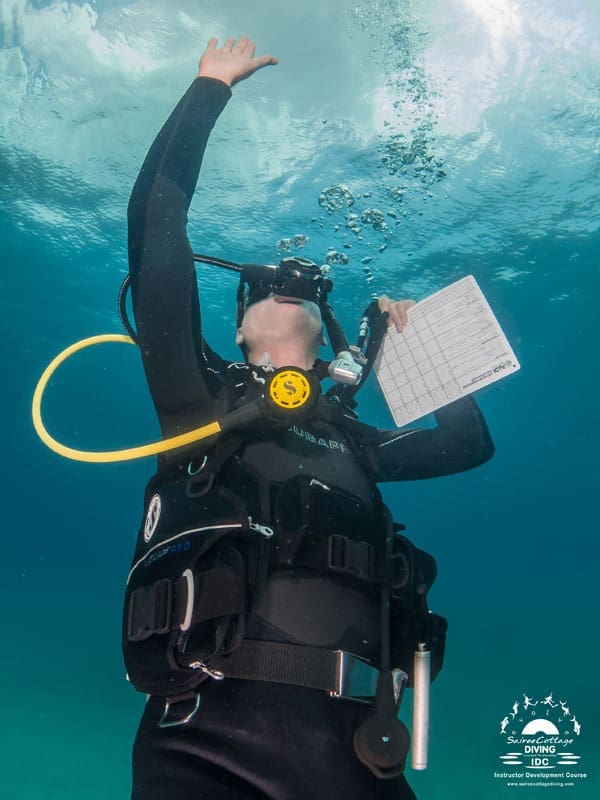
Question 24 – PADI Open Water Knowledge Review 3 Answers
Question 24: Should you always seek medical attention even when a diver looks like he is fully recovered after an accident?
You never know 100% if a diver is fully recovered. There is a good chance that an unresponsive diver underwater has water in the lungs and even a little bit of water can damage the lung. It is therefore important to always do a medical examination with a physician after the event.
Question 25 – PADI Open Water Diver Manual Answers Chapter 3
Question 25: How many visual and audible signaling devices should you have as a scuba diver?
A visual signaling device can be a DSMB which you can inflate like a long, slim, easy-to-see balloon. This will alert boats that you are close to the surface or are making an ascent. You can also use a fully inflated DSMB at the surface to signal boats for help.
An audible signaling device can be a whistle or air horn to alert boats that you need assistance at the surface.
Question 26 – PADI Open Water Diver Manual Answers Chapter 3
Question 26: Do boats always see your Dive Flag?
Most captains are well trained and always look for dive flags, but a captain might miss it, or a dive flag might be hard to see in certain weather conditions.
Never assume a boat will see your dive flag and always stay deep enough until the boat passes.
Always review your PADI Open Water Diver Manual Answers Chapter 3 with a certified PADI Diving Instructor and PADI Dive Shop during your PADI Open Water Diver Course. Read full disclaimer here.
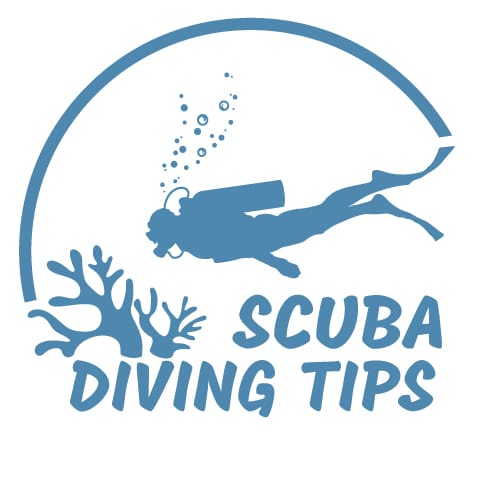

Leave a Reply